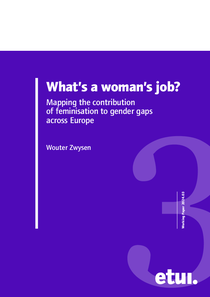What's a woman's job? Mapping the contribution of feminisation to gender gaps across Europe

European Trade Union Institute, Brussels
ETUI - Brussels
2024
45 p.
employment ; gender equality ; women workers ; labour force participation ; segregation ; equal pay ; female occupation
Working Paper
2024.03
Employment
English
Bibliogr.
1994-4446
13.01.3-68699
"Despite some progress, women are still disadvantaged on the labour market. While most policies – pay transparency, awareness raising or anti-discrimination legislation – address the pay gaps between men and women in the same job, less attention is generally given to men and women working in different jobs. Crucially, such segregation is large and can actually widen the gaps as the sheer presence of women in a job seems to lead to a devaluation of those jobs and a reduction in how they are viewed and rewarded. The problem also goes beyond the wage as women also face disadvantage in terms of conditions of work. This paper addresses two issues concerning the horizontal segregation of men and women into different jobs. First, it maps the extent of the separation in jobs and workplaces between men and women and its relationship with gender pay gaps. Second, it shows how this segregation dynamically affects pay and non-monetary working conditions in these more feminised jobs. By taking a longitudinal view, it also becomes clear that several aspects of a job – such as the contract conditions, supervisory responsibilities and pay –become worse over time as more women work in such jobs. The paper points to a need to consider gender equality more widely, not only by focusing on pay differences between men and women in the same job but also on what processes lead to ‘feminine jobs' being valued lower. Devaluation seems to be worse in contexts where women are more disadvantaged – as the gender pay gap is higher – and where employers have more discretion in setting pay and working conditions."
Digital;Paper
ISBN (PDF) : 1994-4454
Legal deposit : D/2024/10.574/04
The ETUI is co-funded by the European Union. Views and opinions expressed are however those of the author(s) only and do not necessarily reflect those of the European Union or the ETUI.